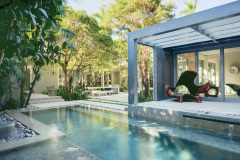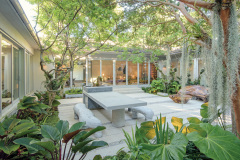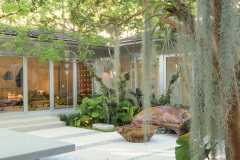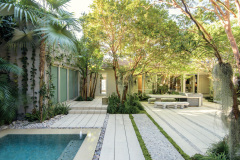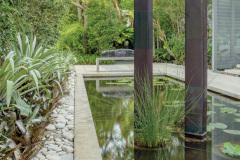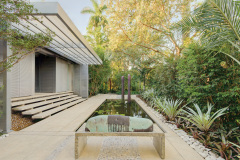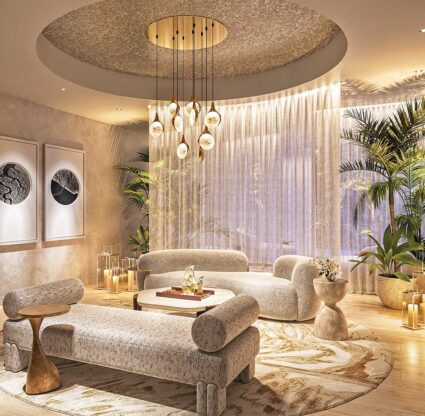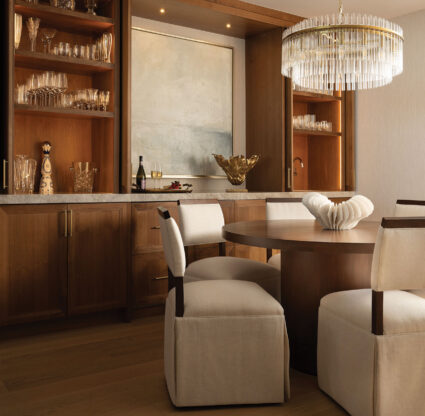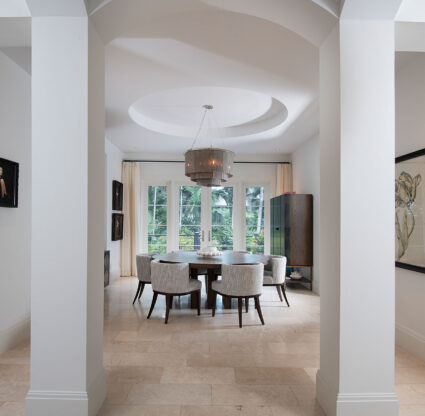Raymond Jungles is not the person you call if you want clipped topiaries and manicured lawns. “We’re not very malleable,” says the landscape architect, known locally for his design of Naples Botanical Garden’s Kathleen and Scott Kapnick Brazilian, Chabraja Visitor Center and Karen and Robert Scott Florida Gardens. “Go to the Brazilian Garden, and you’ll find all the plants I love,” he says.
Naples was formative in Jungles’ design evolution. After graduating from the University of Florida in the mid-‘80s, he worked here for Jo Ann Smallwood, of Smallwood Design Group. “I had to design, design, design, because she was burning the market up—she was on fire,” he says. He kept returning to Southwest Florida over the years, forming part of the dream team that conceived the master plan for Naples Botanical Garden and designing private gardens for big family names, like the Shotwells.
Much has been written about Jungles’ mentoring with Roberto Burle Marx. The Brazilian tropical modern master’s influences are evident in Jungles’ designs at Naples Botanical and in the Miami Beach Modern landscape he completed in 2012—still one of his top projects. Though done more than a decade ago, the home epitomizes Jungles’ plant philosophies, guiding principles developed since his first nursery job in high school.
Principle one: preserve the natural ecosystem. “We don’t believe a blank slate is the best slate,” Jungles says. When starting a project, his team identifies anything of value that can be kept or salvaged. He likes to work with native plants, natural grasses, wildflowers and pollinators that provide habitat for wildlife. He looks to innovators in adjacent fields, like irrigation experts, to ensure gardens require minimal maintenance and have a small ecological footprint. He believes in vernacular design—spaces built for the place and time they’re in—and focuses on using local materials and talent, along with the latest technologies. It’s not about being cutting-edge; rather, his firm focuses on relevance.
When the homeowners of Miami Beach Modern approached Jungles, their home was a nondescript corner lot that looked “as suburban as it could be.” He turned the project down at first but was convinced by the client’s persistence and deep collection of Brazilian midcentury-modern art and design. He got to work doing what he does best: restoring the landscape—essentially, putting things back the way they were before human meddling.
First, he needed to take care of the foundation. Jungles is accustomed to collaborating with architects and believes the landscape and architecture should be planned as one, each having equal weight. In this case, he took on most of the architectural duties, too, starting by replacing the circular driveway out front with a water garden (“That’s like bringing life right to the front entrance,” he says). He turned the entryway into a cantilevered pergola with floating concrete steps and aluminum slats. In the back, he shrunk the pool to make space for more vegetation and communal areas, including a wet deck. He added a cabana bath and massage pavilion, where they now hide equipment behind partially frosted glass. In the primary bedroom, a private garden is also protected with frosted glass that turns opaque with the touch of a button. Inside and out, swaths of glass, corner windows, poured concrete and aluminum slatting create continuity. “We do a lot of big moves like this that have nothing to do with planting,” Jungles says. “Planting is what we do; we love planting, but we have to solve the problems first.”
His philosophy for the greenery is simple: Let the plants talk. “We don’t like to manipulate plants into shapes or forms that are not their natural characteristic,” he says. He allows the site to dictate the plans, opting for vegetation that thrives in its setting with minimal irrigation or maintenance. “There’s nothing like salt and wind to help color your plant palette,” he says, noting that plants that can survive varying tides and storm surges, heavy winds, and salty soil are essential. For aesthetics—and to create privacy barriers—he layers evergreen palms, playing off the varying textures and shades of green. When a site calls for color, he looks to plants that are vibrant by nature, like silver buttonwoods and certain bromeliads. “Silverwoods are used in mass,” he says. “That’s one of the toughest plants there is for this area. They grow right on the beach.”
Around the Miami Beach Modern home, he planted gumbo limbos, Jamaican capers, marlberry shrubs, silver saw palmettos, golden creepers and coontie cycads—plants that canopy with time. (In Southwest Florida gardens, Jungles likes to layer in juncus. “I just love that natural edge,” he says.) The landscape is lush and layered with private gardens, verdant nooks and paths for exploration. “We like living, not sterile gardens,” he adds. Water always plays a central element, whether as a swimming pool, reflection pool, lake (which he adds whenever possible to increase botanical diversity) or all of the above. “Water animates the garden and reflects the surroundings,” he says. “You can buy a piece of art and see it twice in the reflection. It brings in the sky; you see the clouds moving through the space. It just gives so many dimensions of experience in a garden.”
Art, another focal element for Jungles, defines key areas in the backyard and melds with its setting. A pair of shale rock Testigo totems by Colombian sculptor Hugo Zapata float in the entry water garden. In the back, gnarled wooden seating by Brazilian artist Hugo França provides artful places to lounge, as do the Haas Brothers’ concrete benches that seem carved out of the landscape.
Like many of Jungles’ designs, Miami Beach Modern evokes the feeling of being in a treehouse. Every view shows branches that wrap the home and exterior spaces are shaded by big, leafy shrubs and trees. Jungles (and yes, that’s his given name) is the first to admit his work isn’t for everyone. These are gardens for people who love plants and want their world to be a little wild.
Photography by Stephen Dunn


